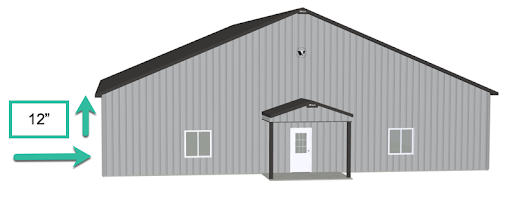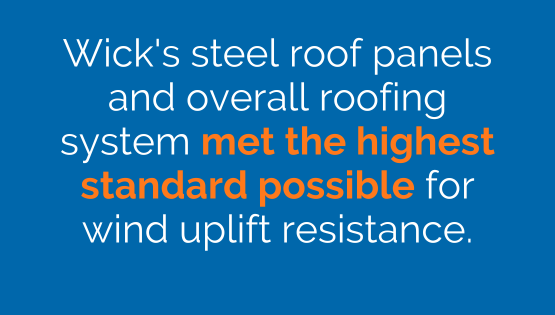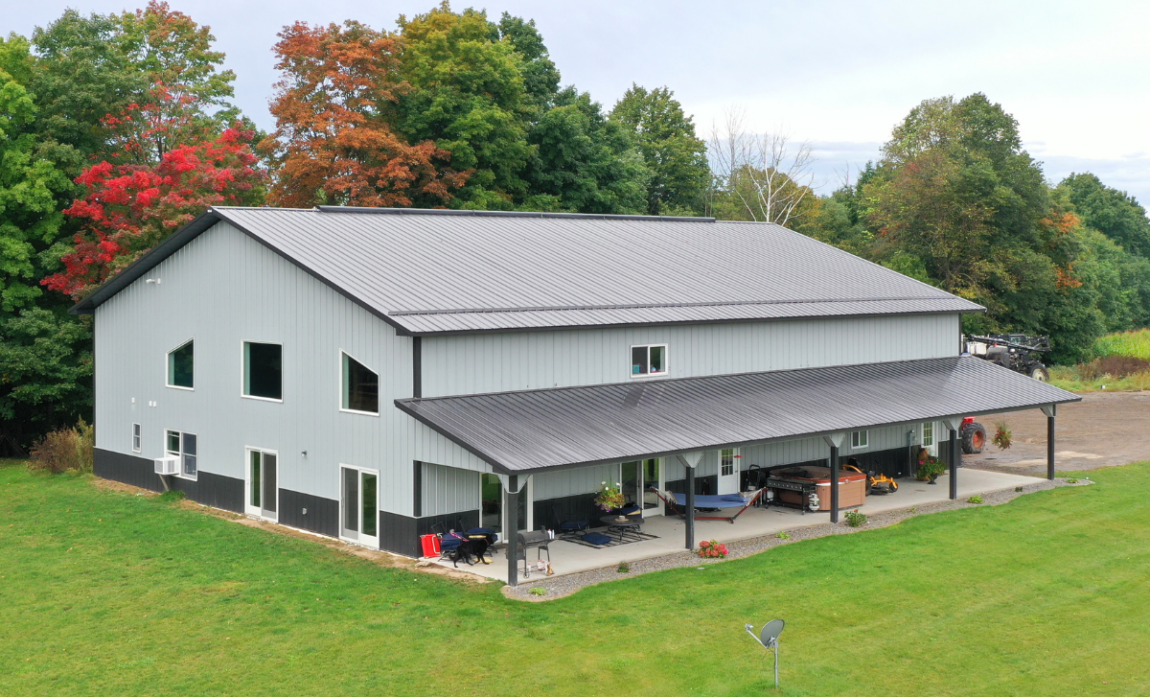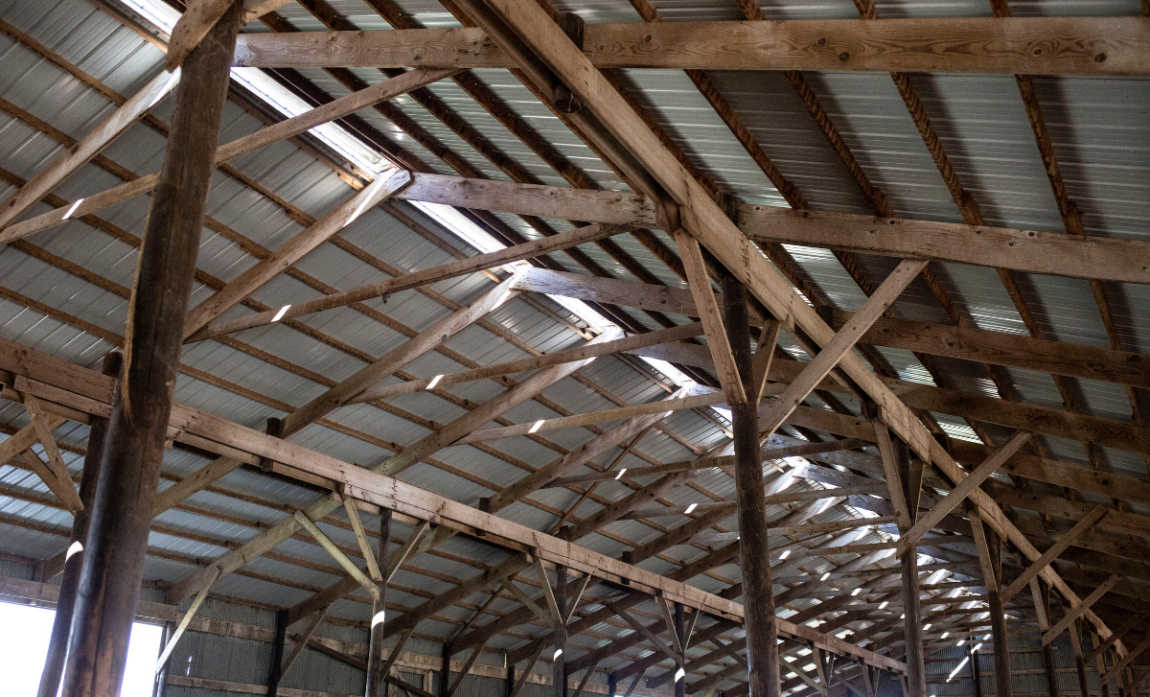Wind resistance should be an important consideration for any pole barn owner in the Midwest.
And when it comes to your pole barn roof, in particular, you want to make sure it meets a high standard for safety. But you shouldn’t just take a pole barn manufacturer’s word for it.
UL Solutions, an independent third-party safety company, recently tested Wick’s roofing system and granted it a Class 90 certification—the highest certification possible for wind uplift resistance.
So what does that really mean for you? In the following, we’ll dive into the significance of this certification for our customers and also describe two additional UL safety certifications that our roofing materials have achieved.
But first, let’s start with some wind resistance fundamentals.
How does wind resistance affect a roof?
Wind is always looking for somewhere to go. So when it hits an object like a pole barn and can’t push through it, that wind will move in different directions. As illustrated below, one of those directions is up, which creates wind uplift.

Note that the more surface area there is—i.e., the wider the building—the greater the upward force. In addition, the size of the overhang can also influence wind uplift.
A 36-inch overhang, for example, presents more surface area and thus catches more wind as opposed to, say, a 12-inch overhang, which provides less shade and protection from the elements but also catches less wind.


(These graphics were created using Wick Building’s free Design 3D™ tool. Check it out!)
When a roof can’t withstand a strong wind force, it can loosen or blow off. And when the latter occurs, three immediate problems emerge:
- Whatever treasure you have inside the building is now exposed to the elements.
- Roof materials become dangerous projectiles that can cause additional property damage and, worse, injury or death to anyone in their path.
- The structural integrity of the building has been compromised, and wind can cause additional damage to the building.
If you’re thinking about purchasing a pole barn, be sure you ask the manufacturer if the roofing system in question has undergone UL 580 safety testing—and then find out what the results were.
What Is UL 580 Safety Testing?
Let’s start with the “UL” in UL 580 testing. This stands for Underwriters Laboratory, an independent third-party safety company founded in 1893 that today goes by the name UL Solutions. One major role of UL Solutions is to certify the safety performance of materials and systems in a variety of industries, including construction, electrical, and healthcare.
“We are the safety science company,” says Rob Woelfle, field engineering business supervisor at UL Solutions, adding that the company also develops and publishes global safety standards. “The last time I checked, we’ve written over 2,000 safety standards.”
As for UL 580 specifically, this is the safety test that measures a roof system’s ability to withstand wind uplift resistance. It involves subjecting a 10-foot by 10-foot roof system sample to various static and oscillating air pressures to measure its performance.
Wick Buildings’ Justin Sommerfeld, a research & development product assistant, has witnessed several UL 58O tests at the UL headquarters in Northbrook, Illinois. “They try to simulate intense wind in all its various manifestations and really be as aggressive as possible to cause a failure in the roof system,” he says.
How did Wick’s roofing system perform in UL 580 testing?
UL 580 testing has four classes of certification: 15, 30, 60, and 90. Each level of certification represents that a roof system has performed sufficiently to a specific set of test standards.
Wick’s steel roof panels and overall system (including our new high-performance fasteners) recently met the safety performance standards for Class 90 certification, the highest certification possible.

This means Wick’s roof system was able to withstand the following environmental conditions. Note that MPH = wind velocities applied for each test phase:

So just how significant is a certification from UL?
“If you’re a consumer,” explains UL’s Woelfle, “the certification indicates that you can be confident an independent third-party safety expert has verified the roof meets a certain standard of safety. It’s not just a claim made by the manufacturer. UL is putting our reputation on the line stating that it meets a certain standard.”
Additional UL Standards that Wick has Achieved
Beyond our Class 90 UL certification for wind uplift resistance, Wick’s proprietary steel roofing panels have received these additional UL certifications:
UL 2218 Impact Resistance, Class 4. Impact resistant certification standards are classified from 1 to 4. Wick steel roof panels have a Class 4 certification, the highest certification possible for impact resistance.
This certification indicates the tensile strength and thickness gauge of Wick’s steel roof panels can withstand the impact of 2-inch diameter steel balls without visible evidence of tearing, cracking, splitting, rupture, crazing, or other openings that would expose the roof.
UL 790 Fire Resistance, Class A. Fire resistance certification standards are classified from A to C. Wick steel roof panels achieved Class A, the highest certification possible for fire resistance.
This certification indicates that Wick’s Class A roof coverings are effective against severe fire test exposures and, more specifically, afford a high degree of protection to the roof deck, do not slip from position, and are not expected to produce flying embers that would start other fires.
What Our UL Certifications Should Mean for You
When you research pole barn manufacturers, keep the significance of Wick’s UL certifications in mind. Yes, they signify that a third-party safety expert has verified our roof materials have met a stringent set of safety standards. But they also indicate the following:
You have the potential for lower insurance rates. From an insurance carrier’s perspective, the UL certifications of our roofing materials help manage risk. For you, that can mean lower insurance rates. If you think about how much you pay for insurance over decades, even seemingly small discounts can really add up.
You can enjoy a lower-maintenance pole barn. Safety and durability go hand in hand. Your Wick roof—and the high safety standards it has met—is less likely to require frequent repairs and maintenance. That saves you time, money, and headaches.
You can gain peace of mind. UL certifications are an external validation for just how serious we are about using safe, durable materials. We go the extra mile to make sure you can trust that our materials are top-notch and that you’ll have a great-performing building for the long term.
Take the Next Step and Start a Conversation with a Wick Builder
Safer products and, ultimately, safer buildings—you’ve just gotten a glimpse of how important these things are to Wick.
If you’d like to learn how a Wick pole barn could be right for your needs, be sure to take the next step and contact a Wick builder.
And if you’re serious about a new pole barn, we recommend you start the process soon. Building a pole barn is no small undertaking. The right design, appropriate materials, and smart construction practices are essential for a safe, durable, and cost-efficient building you’ll love for years to come.






